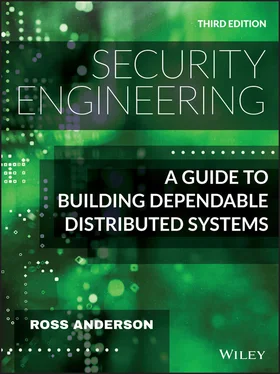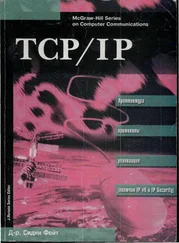1 1 Information about the machines can be seen at the Crypto Museum, https://www.cryptomuseum.com.
2 2 letters in the case of the Hagelin machine used by the USA, permutations in the case of the German Enigma and the British Typex
3 3 More precisely, the probability that fish chosen randomly from fish are different is which is asymptotically solved by [1039].
4 4 This may have been used first at Bletchley in World War II where a key insight into breaking the German Enigma machine was that no letter ever enciphered to itself.
5 5 In fact, we can also construct hash functions and block ciphers from stream ciphers – so, subject to some caveats I'll discuss in the next section, given any one of these three primitives we can construct the other two.
6 6 The likely discrete log algorithm, NFS, involves a large computation for each prime number followed by a smaller computation for each discrete log modulo that prime number. The open record is 795 bits, which took 3,100 core-years in 2019 [302], using a version of NFS that's three times more efficient than ten years ago. There have been persistent rumours of a further NSA improvement and in any case the agency can throw a lot more horsepower at an important calculation.
7 7 In the 1990s could be in the range 512–1024 bits and 160 bits; this was changed to 1023–1024 bits in 2001 [1404] and 1024–3072 bits in 2009, with in the range 160–256 bits [1405].
8 8 The default sizes of are chosen to be 2048 bits and 256 bits in order to equalise the work factors of the two best known cryptanalytic attacks, namely the number field sieve whose running speed depends on the size of and Pollard's rho which depends on the size of . Larger sizes can be chosen if you're anxious about Moore's law or about progress in algorithms.
9 9 See Katz and Lindell [1025] for an introduction.
10 10 The few that can't, try to cheat. In 2011 Iran hacked the CA Diginotar, and in 2019 Kazakhstan forced its citizens to add a local police certificate to their browser. In both cases the browser vendors pushed back fast and hard: Diginotar failed after it was blacklisted, while the Kazakh cert was blocked even if its citizens installed it manually. This of course raises issues of sovereignty.
11 11 The COVID-19 pandemic has given some respite: Microsoft had been due to remove support for legacy versions of TLS in spring 2020 but has delayed this.
12 12 One of them, the McEliece cryptosystem, has been around since 1978; we've had digital signatures based on hash functions for about as long, and some of us used them in the 1990s to avoid paying patent royalties on RSA.
Anything your computer can do for you it can potentially do for someone else.
– ALAN COX
Microsoft could have incorporated effective security measures as standard, but good sense prevailed. Security systems have a nasty habit of backfiring and there is no doubt they would cause enormous problems.
– RICK MAYBURY
I first learned to program on an IBM mainframe whose input was punched cards and whose output was a printer. You queued up with a deck of cards, ran the job, and went away with printout. All security was physical. Then along came machines that would run more than one program at once, and the protection problem of preventing one program from interfering with another. You don't want a virus to steal the passwords from your browser, or patch a banking application so as to steal your money. And many reliability problems stem from applications misunderstanding each other, or fighting with each other. But it's tricky to separate applications when the customer wants them to share data. It would make phishing much harder if your email client and browser ran on separate machines, so you were unable to just click on URLs in emails, but that would make life too hard.
From the 1970s, access control became the centre of gravity of computer security. It's where security engineering meets computer science. Its function is to control which principals (persons, processes, machines, …) have access to which resources in the system – which files they can read, which programs they can execute, how they share data with other principals, and so on. It's become horrendously complex. If you start out by leafing through the 7000-plus pages of Arm's architecture reference manual or the equally complex arrangements for Windows, your first reaction might be ‘I wish I'd studied music instead!’ In this chapter I try to help you make sense of it all.
Access control works at a number of different levels, including at least:
1 Access controls at the application level may express a very rich, domain-specific security policy. The call centre staff in a bank are typically not allowed to see your account details until you have answered a couple of security questions; this not only stops outsiders impersonating you, but also stops the bank staff looking up the accounts of celebrities, or their neighbours. Some transactions might also require approval from a supervisor. And that's nothing compared with the complexity of the access controls on a modern social networking site, which will have a thicket of rules about who can see, copy, and search what data from whom, and privacy options that users can set to modify these rules.
2 The applications may be written on top of middleware, such as a web browser, a bank's bookkeeping system or a social network's database management system. These enforce a number of protection properties. For example, bookkeeping systems ensure that a transaction that debits one account must credit another, with the debits and credits balancing so that money cannot be created or destroyed; they must also allow the system's state to be reconstructed later.
3 As the operating system constructs resources such as files and communications ports from lower level components, it has to provide ways to control access to them. Your Android phone treats apps written by different companies as different users and protects their data from each other. The same happens when a shared server separates the VMs, containers or other resources belonging to different users.
4 Finally, the operating system relies on the processor and its associated memory-management hardware, which control which memory addresses a given process or thread can access.
As we work up from the hardware through the operating system and middleware to the application layer, the controls become progressively more complex and less reliable. And we find the same access-control functions being implemented at multiple layers. For example, the separation between different phone apps that is provided by Android is mirrored in your browser which separates web page material according to the domain name it came from (though this separation is often less thorough). And the access controls built at the application layer or the middleware layer may largely duplicate access controls in the underlying operating system or hardware. It can get very messy, and to make sense of it we need to understand the underlying principles, the common architectures, and how they have evolved.
I will start off by discussing operating-system protection mechanisms that support the isolation of multiple processes. These came first historically – being invented along with the first time-sharing systems in the 1960s – and they remain the foundation on which many higher-layer mechanisms are built, as well as inspiring similar mechanisms at higher layers. They are often described as discretionary access control (DAC) mechanisms, which leave protection to the machine operator, or mandatory access control (MAC) mechanisms which are typically under the control of the vendor and protect the operating system itself from being modified by malware. I'll give an introduction to software attacks and techniques for defending against them – MAC, ASLR, sandboxing, virtualisation and what can be done with hardware. Modern hardware not only provides CPU support for virtualisation and capabilities, but also hardware support such as TPM chips for trusted boot to stop malware being persistent. These help us tackle the toxic legacy of the old single-user PC operating systems such as DOS and Win95/98 which let any process modify any data, and constrain the many applications that won't run unless you trick them into thinking that they are running with administrator privileges.
Читать дальше











